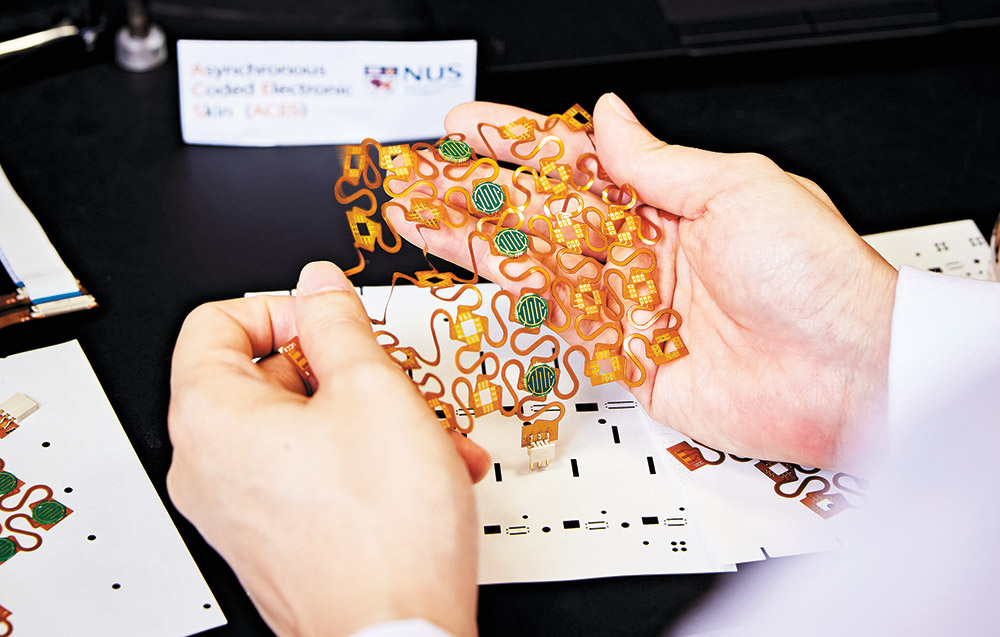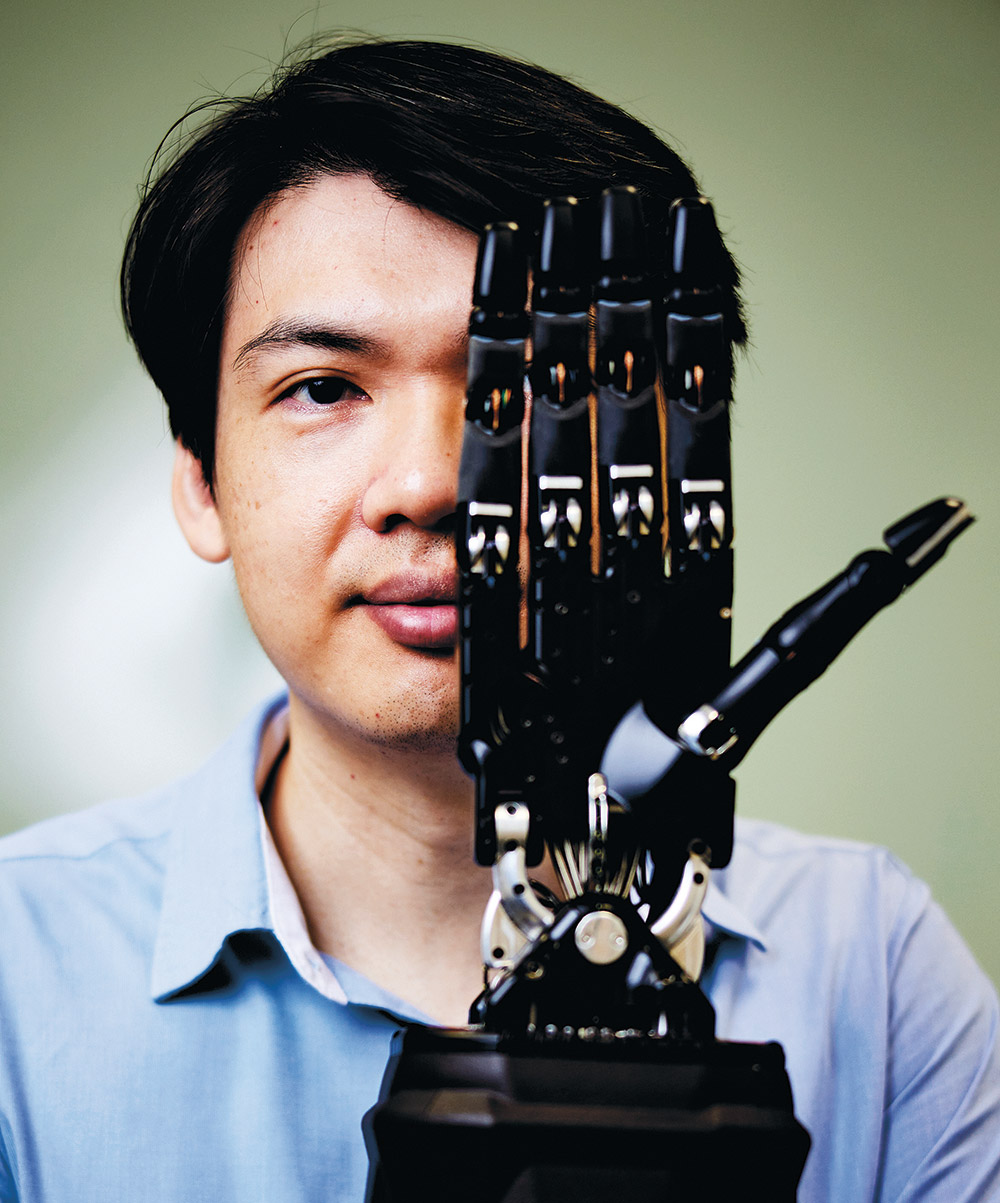Searching for a New Sensation
Assistant Professor Benjamin C. K. Tee from the NUS Department of Materials Science and Engineering, and Institute for Health Innovation & Technology, regularly makes the news with his innovations — which range from self-healing electronic skin to a foam that emulates the human sense of touch.
 The artificial skin and its related technologies that Asst Prof Tee is developing cut across multiple disciplines, offering benefits to robotics, medicine and even consumer goods.
The artificial skin and its related technologies that Asst Prof Tee is developing cut across multiple disciplines, offering benefits to robotics, medicine and even consumer goods.
More Than Skin Deep
At NUS, Assistant Professor Benjamin C. K. Tee leads the Sensor.AI Systems Labs at the Department of Materials Science and Engineering. He earned his PhD in Electrical Engineering from Stanford University in 2013, and was a Stanford Biodesign Global Innovation Fellow in 2014. The winner of the Singapore Young Scientist Award in 2016, he received the NRF Fellowship the following year, and in 2019 was recognised as the WEF Young Scientist of the Year. Asst Prof Tee has more than 10 patents to his name, and serves on the IEEE Electron Devices Society Flexible Electronics and Displays committee and the Materials Research Society Singapore Committee.
We have all been there: a momentary lapse of concentration that exposes your mobile phone to a damaging force of impact. The results, depending on the angle of contact, could range from an innocuous scratch to a cracked screen. What has never happened before, is discovering later that the damaged screen has magically fixed itself. Welcome to the world of Assistant Professor of Materials Science and Engineering Benjamin C. K. Tee, where the third law of science fiction writer and futurist Arthur C. Clarke (that states: “any sufficiently advanced technology is indistinguishable from magic”) is in full effect.
Self-healing materials have made the news in recent years — including widely-publicised experiments in creating new kinds of more sustainable and resilient concrete — but this barely scratches the surface of their potential. In fact, what drives Asst Prof Tee is an abiding interest in emulating our skin’s ability to feel and generally provide us with feedback about the environment.
A powerful demonstration for this potential is in a video he uses and discusses often. In it, a man can be seen struggling to get out of a wheelchair, though there is nothing visibly wrong with him and it appears to be a demonstration for the cameras. After a brief struggle, the man fails to rise from his seated position, instead falling to the ground. Asst Prof Tee explains that the man has lost the ability to feel, meaning that he cannot even tell how much pressure he is exerting on the ground — which is why he falls. “We use our skin from the cradle to the grave…What we are doing is looking into how skin works and then recreating that in artificial devices,” says Asst Prof Tee, neatly summarising his most famous work to date. How famous exactly? Well, aside from being featured in prestigious journals such as
Nature Materials, Nature Electronics and Science Robotics, the artificial skin that Asst Prof Tee and his team pioneered has been covered regionally by CNA and internationally by CNN and
The Wall Street Journal. There are a lot of dimensions to this innovation, ranging from self-healing materials to an artificial nervous system. Asst Prof Tee notes that these developments are truly on the cutting edge of what is practically possible with today’s technology — and some of tomorrow’s too. The team is hard at work refining their concepts, even during the COVID-19 pandemic, with news breaking in May this year on their new soft material that mimics our sense of touch called artificially innervated foam (AiFoam).
 What drives Asst Prof Tee is an abiding interest in emulating our skin’s ability to feel and provide us with feedback about the environment.
What drives Asst Prof Tee is an abiding interest in emulating our skin’s ability to feel and provide us with feedback about the environment.
From Science Fiction to Fact
Asst Prof Tee’s own adventure in the area of engineering artificial skin began years ago, when he pioneered self-healing material while working on his PhD. Then again, the story perhaps goes back further. Thanks to all the media attention, we know that he was inspired by a pivotal scene in
Star Wars: The Empire Strikes Back. The scene in question of course is tied to the film’s shocking climax, when the hero Luke Skywalker loses his hand in a duel with the villainous Darth Vader. He receives a prosthetic replacement, which the film’s creator George Lucas showed us allows him to feel, exactly as if the robotic limb was his own hand. Asst Prof Tee cites this as his eureka moment; he was seven at the time. He later realised that there was an opportunity there. “When you lose your sense of touch, you essentially become numb…and prosthetics users face that problem,” he told journalists at CNA. “So by recreating an artificial version of the skin, they can hold a hand, and feel that it is soft and warm. They can feel how hard they are holding that hand.”
Continuing on the theme of turning science fiction into science fact, Asst Prof Tee explains that artificial skin can actually move into “superhuman” territory, because it is not limited by biology. There is even a sustainability angle, which is where that example of the smartphone touchscreen comes into the picture. “Your phone’s touchscreen is essentially like an artificial skin,” says Asst Prof Tee. “If we can engineer it to repair itself, we can cut down on electronic waste.” This is a useful reminder that artificial skin and its related technologies that Asst Prof Tee is developing at NUS cut across multiple disciplines, offering benefits to robotics, medicine and even consumer goods.
In the example of prosthetics, the challenge remains how artificial skin connects with the human nervous system. Asst Prof Tee says that he and his team are riding the wave of improvements in neurotechnological interfaces to offer an advantage in terms of speed. For the record, the artificial skin developed by Asst Prof Tee is already capable of transmitting information more efficiently than anything in our own biology. The hurdle remains at the level of integrating all that potential with our nervous system, but that does not mean the artificial skin will not have an immediate practical impact. “Think of it this way: we are now at the stage of the 56kbps dial-up modem,” he says. “It will take maybe 10 years (for the human-machine interface), but we already have practical applications in robotics.”

I want to see the research that I do have an impact in the world, and prosthetics was quite obvious.
Assistant Professor Benjamin C. K. Tee
Acing the Touch Test
While some artificial skin applications, such as the self-healing mobile phone screen, remain fictional, Asst Prof Tee’s work at NUS has made the news for its real-world applications. In the area of robotics, he and his team integrated an artificial nervous system with the electronic skin to enable a machine to perform what would be a simple task for a human — pick up a soft drink can. He tells us that this was done by linking the electronic skin to an emulated biological neural network, which runs on an energy-efficient neuromorphic Intel Loihi chip. Again, efficiency is one the hallmarks here, with the Asynchronous Coded Electronic Skin (ACES) only needing one wire to send information to the processing system.
ACES is also more sensitive than human skin in some ways, transmitting information more than 1,000 times faster. For some context, it can identify shape, texture and hardness 10 times faster than the blink of a human eye. This is all possible thanks to the system being uninhibited by the limits of biology, as Asst Prof Tee alluded. In the published reports on this latest application of ACES, it is noted that robots previously relied only on visual senses to perform actions, with the application of pressure being programmed into the device. Asst Prof Tee and Asst Prof Harold Soh combined seeing and touching, pairing them to great effect with the neural network; both professors are members of the Intel Neuromorphic Research Community (INRC).
Reaching Out to Connect
All of the different applications — both current and potential — illustrate why the multi-disciplinary approach in the sciences is so important. “Today’s types of problems are no longer well defined, because of the interconnectedness of technology,” says Asst Prof Tee. “I want to see the research that I do have an impact in the world, and prosthetics was quite obvious (
in shaping how he bridged the gap between electrical engineering and the fields of biology and medicine).”
It is for this reason that Asst Prof Tee hopes more students will consider the broad range of engineering disciplines. Computer science may be the popular choice, but the world still needs specialists in materials science and electrical engineers too. Showcasing his keen concern for real-world application, Asst Prof Tee asserts that no matter what technology one develops in a particular field, one needs to rope in experts from other fields to realise the practical benefits. One thing is for certain: there are plenty more multidisciplinary innovations on the way from Asst Prof Tee and his team, as they strive to take the ‘fiction’ out of science fiction.
Text by Ashok Soman. Photos by Alvin Teo